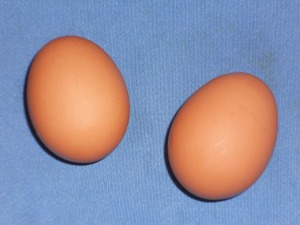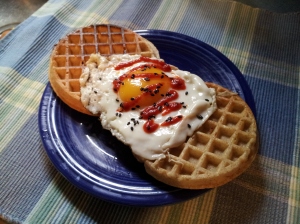Food, Second Among the Arts
by Aaron Kagan
 Let’s start with the obvious: is food art? Well, you who have milked the tender flesh from a barbecued rib, is it?
Let’s start with the obvious: is food art? Well, you who have milked the tender flesh from a barbecued rib, is it?
Definitions for what is and isn’t art abound, and you’re sure to find plenty that would exclude food, but the authors of those definitions are probably soulless porridge slurpers who have never thought to push their face into a loaf of fresh bread, an experience which can move the soul far more than standing in line to see the Mona Lisa, who was probably smiling because she was thinking about something she ate.
Not only is food art, but it is more intensely sensual than most of what we call the arts. Michelangelo’s David is spectacular to behold, but you don’t get to slather it in butter and stick it in your mouth, and so in that sense it is inferior to a piece of toast. Art is meant to stir the senses, and neither a ballet nor a bas relief can rival the sensation of cracking through the sweet glass of creme brulee to probe the embarrassing riches below. Not that pedigreed desserts with foreign names are the only convincing examples of food’s sensory superiority. If forced to choose only one of the following for the rest of my life, I would take an unadorned, bloody garden tomato, hot from the sun, over any piece of art ever created. There are those who prefer poetry over painting, but everyone would rather have a donut.
But wait, you say. Whether or not something is art is not solely defined by how sensual it is. If it were, then wouldn’t sex be the ultimate art? Yes, it would be, and is. Stop drawing little lines around everything and go have a bowl of chowder, you’ll feel better.
Of course in competition with other art forms, food has the unfair advantage of going directly to the soul via the stomach (that’s a biochemical fact). Music comes close, bypassing our skeptical eyes, but we are simply wired to be moved by the experience of consuming food above any other human activity. Our tongues tell our brains that calories equal survival. Sweets drive us mad because the taste means “eat more of this, it is efficient fuel!” Umami, the so called fifth taste, which roughly translates to meatiness, advertises essential amino acids, the taste of salt implies once precious minerals, and so on. A good cook (or a manipulative junk food manufacturer) can play on our weaknesses for these substances until we buckle, begging for more. A dish that contains all of these compelling flavors, like ice cream with pretzels in it, makes our brains think that if we kept eating it, we would live forever. The powerful psychological influence of food is why Esau traded his birthright for some lentils: just imagine what he would have given up for ice cream with pretzels in it.
Food is not only the second most intensely sensual art, but the most multi-sensory art. Forget the production and creation of food – the feel of the spade churning loamy soil, the sight of a tree pregnant with blushing pears – and say you’re sitting down to a plate of food either at home or in a restaurant. The visual component is most apparent. There is raw beauty in the natural colors, shapes, and textures of the ingredients. The Damascus steel, maroon swirls in a cube of raw beet flesh. A primitivist could happily stop here. But while paint is pretty right out of the tube, that’s just the beginning. When a raw ingredient becomes part of a more complex dish, the beauty is corresponding more complex. Compare a kernel of wheat to a heaping pile of angel hair with a dusting of parmesan, freshly chopped herbs and cracked black pepper. And you could do everything a museum does to enhance the object in terms of framing — in this case tableware — lighting and general ambience, which is exactly what restaurants do. There’s a reason that chefs refer to the appearance of the plate as the composition.
Then there is the symphony of carbon dioxide in a sizzling glass of champagne, or soda, the report of a raw green bean, the portentous hiss of fajitas. Sculptures look so fun to fondle, but you typically can’t do so without a security escort out of the museum. But oh, the heft of a good sandwich in hand, the tussle with a lobster claw, the sensation of literally breaking bread with your bare hands. And that’s all before it gets to your mouth.
And with few exceptions, food is certainly the best smelling of the arts.
 Another way that food counts as art is that it is created by chefs and chefs are artists. Composing a stunning plate can take as much time and skill as painting a portrait, and some chefs even use actual brushstrokes, as in a swipe of ganache accenting a slice of cake. Plus chefs have the most necessary makings of any artist: rigorous training and moody temperaments. And they’re not in it for their health. There are much easier ways to make money than manning a broiler and occasionally slicing into one’s fingers. Chefs have the intention of doing something meaningful with their time on this earth and creating something that will inspire you. My grandmother may be gone, but we’re still talking about her blintzes. I wish they were all I ever talked about.
Another way that food counts as art is that it is created by chefs and chefs are artists. Composing a stunning plate can take as much time and skill as painting a portrait, and some chefs even use actual brushstrokes, as in a swipe of ganache accenting a slice of cake. Plus chefs have the most necessary makings of any artist: rigorous training and moody temperaments. And they’re not in it for their health. There are much easier ways to make money than manning a broiler and occasionally slicing into one’s fingers. Chefs have the intention of doing something meaningful with their time on this earth and creating something that will inspire you. My grandmother may be gone, but we’re still talking about her blintzes. I wish they were all I ever talked about.
If you’re still not convinced, consider the works of Thomas Kinkade, a man largely considered to be an artist by trade. I could fry an egg that would out-art that crap.
Aaron Kagan is the editor of Eater Boston and is a freelance food journalist whose writing has appeared in The Boston Globe, Smithsonian.com, Meatpaper, and other publications. Though not trained as a chef, he has worked professionally as a cook. email: [email protected]
_____
Related articles from The Muse Dialogue:
“An Art Overlooked” by Andrew Swensen
“The Aesthetics of Food” by Rachel Hite
“Mimesis and Molecular Gastronomy” by Rachel Hite










love the article aaron. my cooking probably doesn’t count as art……..but maybe even bad art is better than no art at all? ha!